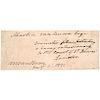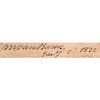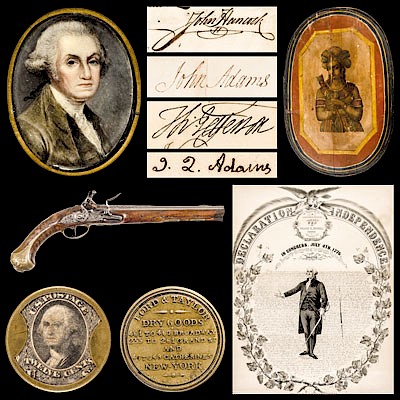1832 MARTIN VAN BUREN Signed Autographed Full Title as U.S. Minister to Britain
Lot 77
Estimate:
$500 - $600
Absentee vs Live bid
Two ways to bid:
- Leave a max absentee bid and the platform will bid on your behalf up to your maximum bid during the live auction.
- Bid live during the auction and your bids will be submitted real-time to the auctioneer.
Bid Increments
| Price | Bid Increment |
|---|---|
| $0 | $10 |
| $200 | $20 |
| $300 | $25 |
| $500 | $50 |
| $1,000 | $100 |
| $2,000 | $200 |
| $3,000 | $250 |
| $5,000 | $500 |
| $10,000 | $1,000 |
| $20,000 | $2,000 |
| $30,000 | $2,500 |
| $50,000 | $5,000 |
| $100,000 | $10,000 |
| $200,000 | $20,000 |
| $300,000 | $25,000 |
| $500,000 | $50,000 |
About Auction
By Early American History Auctions
Jun 1, 2019
Set Reminder
2019-06-01 12:00:00
2019-06-01 12:00:00
America/New_York
Bidsquare
Bidsquare : Historic Autographs, Colonial Currency, Political Americana & Revolutionary War Era
https://www.bidsquare.com/auctions/early-american-history-auctions/historic-autographs-colonial-currency-political-americana-revolutionary-war-era-4152
Historic Autographs, Coins, Currency, Political, Americana, Historic Weaponry and Guns, John Adams, Thomas Jefferson, Early American History Auctions auctions@earlyamerican.com
Historic Autographs, Coins, Currency, Political, Americana, Historic Weaponry and Guns, John Adams, Thomas Jefferson, Early American History Auctions auctions@earlyamerican.com
- Lot Description
Autographs
1832 Martin Van Buren Signed Autograph With Full Title While Acting United States Minister to the United Kingdom
MARTIN VAN BUREN (1782-1862). 8th President of the United States (1837-1841), First President of the United States who was born as an actual American Citizen! A founder of the Democratic Party, served as the 9th Governor of NY, the 10th U.S. Secretary of State, and the 8th Vice President of the United States.
January 7, 1832-Dated, Signed Autograph Panel With Full Title Signed, "M. Van Buren" while U.S. Minister to the United Kingdom, measuring 2.5" x 6.5", 1 page with blank reverse, Very Fine. Easily removable blue paper traces from a prior display on the reverse sides, otherwise clean and boldly written in rich deep brown ink on wove period paper. Titled across the top "Martin Van Buren Esqr -- Minister plenipotentiary & Envoy extraordinary to the Court of St. James' London." Signed on the bottom left of the panel's conclusion Signed, "M. Van Buren - Jany. 7th, 1832" with his signature measuring a large 2.5" long. Rarely seen in this form, and the first we have offered as such.
Martin Van Buren (born Maarten Van Buren, December 5, 1782 - July 24, 1862) was the Eighth president of the United States from 1837 to 1841. A founder of the Democratic Party, he previously served as the ninth governor of New York, the tenth U.S. secretary of state, and the eighth vice president of the United States.
He won the 1836 presidential election with the endorsement of popular outgoing President Andrew Jackson and the organizational strength of the Democratic Party. He lost his 1840 reelection bid to Whig Party nominee William Henry Harrison, due in part to the poor economic conditions of the Panic of 1837. Later in his life, Van Buren emerged as an elder statesman and important anti-slavery leader, who led the Free Soil Party ticket in the 1848 presidential election.
Van Buren was born in Kinderhook, New York to a family of Dutch Americans; his father was a Patriot during the American Revolution. He was raised speaking Dutch and learned English at school, making him the only U.S. President who spoke English as a second language.
He trained as a lawyer and quickly became involved in politics as a member of the Democratic-Republican Party. He won election to the New York State Senate and became the leader of the Bucktails, the faction of Democratic-Republicans opposed to Governor DeWitt Clinton. Van Buren established a political machine known as the Albany Regency and in the 1820s emerged as the most influential politician in his home state.
He was elected to the United States Senate in 1821 and supported William H. Crawford in the 1824 presidential election. John Quincy Adams won the 1824 election and Van Buren opposed his proposals for federally funded internal improvements and other measures. Van Buren's major political goal was to re-establish a two-party system with partisan differences based on ideology rather than personalities or sectional differences, and he supported Jackson's candidacy against Adams in the 1828 presidential election with this goal in mind.
To support Jackson's candidacy, Van Buren ran for Governor of New York and resigned a few months after assuming the position to accept appointment as U.S. Secretary of State after Jackson took office in 1829.
Van Buren was a key advisor during Jackson's eight years as President of the United States and he built the organizational structure for the coalescing Democratic Party, particularly in New York. He resigned from his position to help resolve the Petticoat affair, then briefly served as the American ambassador to Britain. At Jackson's behest, the 1832 Democratic National Convention nominated Van Buren for Vice President of theUnited States, and he took office after the Democratic ticket won the 1832 presidential election.
With Jackson's strong support, Van Buren faced little opposition for the presidential nomination at the 1835 Democratic National Convention, and he defeated several Whig opponents in the 1836 presidential election. Van Buren's response to the Panic of 1837 centered on his Independent Treasury system, a plan under which the Federal government of the United States would store its funds in vaults rather than in banks.
He also continued Jackson's policy of Indian removal; he maintained peaceful relations with Britain but denied the application to admit Texas to the Union, seeking to avoid heightened sectional tensions. In the 1840 election, the Whigs rallied around Harrison's military record and ridiculed Van Buren as "Martin Van Ruin", and a surge of new voters helped turn him out of office.
At the opening of the Democratic convention in 1844, Van Buren was the leading candidate for the party's nomination for the presidency. Southern Democrats, however, were angered by his continued opposition to the annexation of Texas, and the party nominated James K. Polk. Van Buren grew increasingly opposed to slavery after he left office, and he agreed to lead a third party ticket in the 1848 presidential election, motivated additionally by intra-party differences at the state and national level. He finished in a distant third nationally, but his presence in the race most likely helped Whig nominee Zachary Taylor defeat Democrat Lewis Cass.
Van Buren returned to the Democratic fold after the 1848 election, but he supported Abraham Lincoln's policies during the American Civil War. His health began to fail in 1861 and he died in July 1862 at age 79. He has been generally ranked as an average or below-average U.S. President by historians and political scientists.
In August 1831 Andrew Jackson gave Van Buren a recess appointment as the ambassador to Britain, and Van Buren arrived in London in September. He was cordially received, but in February 1832 he learned his nomination had been rejected by the Senate. The rejection of Van Buren was essentially the work of Calhoun.
When the vote on Van Buren's nomination was taken, enough pro-Calhoun Jacksonians refrained from voting to produce a tie, thus giving Calhoun, in his role as presiding officer, the ability to cast the deciding vote against Van Buren. Calhoun was elated, convinced that he had ended Van Buren's career. "It will kill him dead, sir, kill him dead. He will never kick, sir, never kick", Calhoun exclaimed to a friend.
Calhoun's move backfired; by making Van Buren appear the victim of petty politics, Calhoun raised Van Buren in both Jackson's regard and the esteem of others in the Democratic Party. Far from ending Van Buren's career, Calhoun's action gave greater impetus to Van Buren's candidacy for vice president. Seeking to ensure that Van Buren would replace Calhoun as his running mate, Jackson had arranged for a national convention of his supporters.
The May 1832 Democratic National Convention subsequently nominated Van Buren to serve as the party's vice presidential nominee. Van Buren won the nomination over Philip Pendleton Barbour (Calhoun's favored candidate) and Richard Mentor Johnson due to the support of Jackson and the strength of the Albany Regency.
Upon Van Buren's return from Europe in July 1832, he became involved in the Bank War, a struggle over the re-charter of the Second Bank of the United States. Van Buren had long been distrustful of banks, and he viewed the Bank as an extension of the Hamiltonian economic program, so he supported Jackson's veto of the Bank's re-charter. Henry Clay, the presidential nominee of the National Republicans, made the struggle over the Bank the key issue of the presidential election of 1832.
The Jackson-Van Buren ticket won the 1832 election by a landslide, and Van Buren took office as Vice President in March 1833. During the Nullification Crisis, Van Buren counseled Jackson to pursue a policy of conciliation with South Carolina leaders. He played little direct role in the passage of the Tariff of 1833, but he quietly hoped that the tariff would help bring an end to the Nullification Crisis, which it did.
During his time in office Van Buren continued to be one of Jackson's primary advisors and confidants, and accompanied Jackson on his tour of the northeastern United States in 1833. Jackson's struggle with the Second Bank of the United States continued, as the president sought to remove federal funds from the Bank.
Though at first apprehensive of the removal due to congressional support for the Bank, Van Buren eventually came to support Jackson's policy. He also helped undermine a fledgling alliance between Jackson and Daniel Webster, a senator from Massachusetts who could have potentially threatened Van Buren's project to create two parties separated by policy differences rather than personalities.
During Jackson's second term, the president's supporters began to refer to themselves as members of the Democratic Party. Meanwhile, those opposed to Jackson, including Clay's National Republicans, followers of Calhoun, and many members of the Anti-Masonic Party, coalesced into the Whig Party.
- Shipping Info
-
Early American provides in-house worldwide shipping. Please contact us directly if you have questions about your specific shipping requirements.
-
- Buyer's Premium



 EUR
EUR CAD
CAD AUD
AUD GBP
GBP MXN
MXN HKD
HKD CNY
CNY MYR
MYR SEK
SEK SGD
SGD CHF
CHF THB
THB













